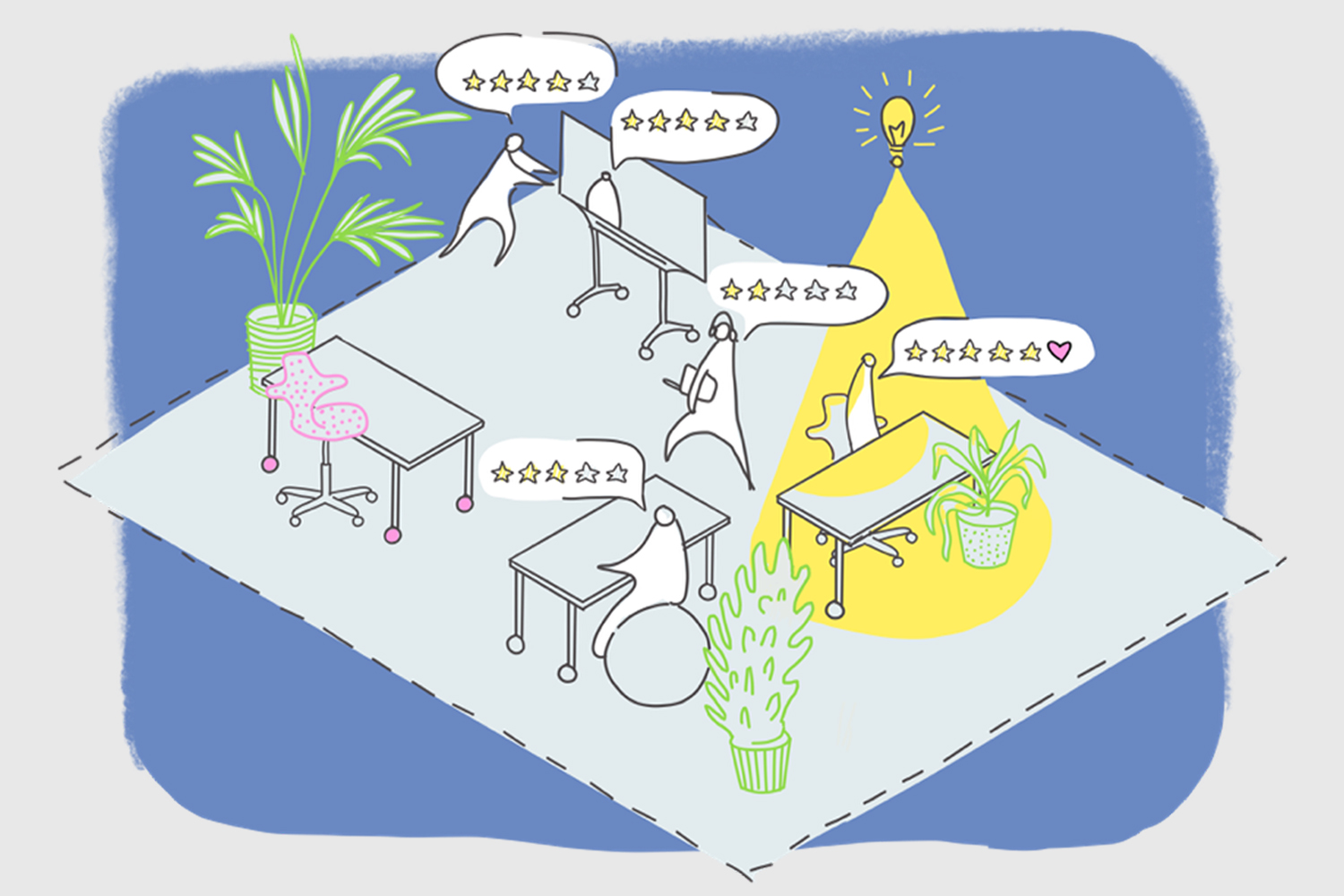
Pilot projects | Hybrid work model
What is a work environment pilot study? How do we perform it when designing a workspace strategy for virtual teams? At the end of January, we completed the first phase of a hybrid work environment pilot project for one of our clients. We would like to share our conclusions.
Where and when did the pilot study take place?
- Industry: BPO/SCC
- Employees: approx. 1,700
- Duration: 01/08/2020 – 22/01/2021 (1 month – preparation, 3 months – tests, 1 month – report)
- People involved: a group of about 10 people: three designers and researchers from Workplace and the Client’s team
What do we mean by a pilot project?
We performed an organisational and spatial simulation of a hybrid work environment. A hybrid model i.e. work physically divided into office, home and other spaces. We rented the following free of charge for the period of three months: furniture, mobile booths and meeting rooms, technologies, greenery, acoustic solutions and lighting elements, which were arranged in an area of about 600 sq m.
The pilot study was a natural continuation of the work nature study (Q2 2020) and the formulation of a new work environment strategy (Q3 2020) for the organisation. Teams performing a variety of activities took part in the project and used the prepared space in rotation. The proposed furnishings were tested and evaluated on an ongoing basis by project participants using an online survey that we created. At the end of the testing period, the results were further explored and discussed in workshops with the users.
What exactly did we test?
First of all, a new workspace strategy consisting of:
- a new typology of space in a hybrid model,
- several organisational scenarios for sharing space between teams,
- technological solutions for space management,
- furniture solutions: from chairs and armchairs, through desks and tables, to mobile booths and rooms of various manufacturers,
- acoustic solutions (e.g. acoustic curtains, panels) and sound masking,
- innovative lighting solutions based on indirect and direct lighting systems.
What are the conclusions?
We got a lot of valuable feedback about what worked and what did not in the case of this particular client. As a result, we have the first conclusions on what to invest in when building a new type of hybrid office. We present them below.
- The pilot study began during the first lockdown. A total of 80 people tested the prepared working environment. Despite the large number of valuable conclusions, the test should be repeated when the virus-related fears are over.
- An important solution in the post-lockdown office are mobile booths and rooms. We tested three manufacturers (with the best reviews) and three different sizes. Booths equipped with a stand for individual work – a height-adjustable desk and an ergonomic chair – were very popular. We were concerned mainly about ventilation – providing fresh air was usually the biggest challenge. Other (not selected for testing) products of this type on the market are underdeveloped in terms of acoustics, ergonomics and even sensory issues (they smell of glue). This results in a reluctance to use them. Those that were tested were ‘good enough’ for users. If we need to purchase such products, it is better to invest in quality. You cannot argue with numbers:
- 10 products of average quality, used in 30 per cent (2.5 h per day) for PLN 25,000 per item equals a total of PLN 250,000 Only PLN 75,000 is actively working.
- If we buy 8 products of good quality, used in 75 per cent (6 h per day) for PLN 250,000, then PLN 187,500 of capital is actively working. It makes no sense to buy products that will not be used most of the time.
- The most important conclusion about acoustic booths is that they lose quality when they are disassembled and then reassembled. Thus, when buying them, it is worth considering the possibility of moving them easily around one floor, avoiding disassembly.
- The hybrid model (in which 30-70 per cent of people work remotely from home) can be one of the most difficult scenarios to implement organisationally. This is evident from the benchmark we have created thanks to companies that were actively testing such a work environment before the pandemic. It is organisationally easier to maintain remote work at a high level, while ensuring wellbeing and a sense of belonging. It will also be crucial to educate managers and leaders, i.e. equip them with tools to manage in such an environment.
- In one of the areas with lots of greenery where you could rent a desk, we played bird sounds from a speaker. This was supposed to make work more pleasant, but it actually distracted people. So we go back to the old idea, i.e. people like the sound of birds, but in toilets.
- Much more energy and attention needs to be devoted to technological solutions in the hybrid model. This is a theme that will need more attention in pilot projects. Especially now, a range of technologies for communication, hybrid work, managing the space and ourselves in it is desirable. This theme is a separate project within a project.
What’s next?
Our recommendation is to start preparing for the next pilot project in Q2 2021. The test itself should start in the third quarter, but we expect most qualitative data to be collected in late 2021. We would love to meet with companies and individuals who have also experimented with the topic of pilot projects of hybrid work environment models and want to exchange knowledge! This will help us to develop a new hybrid typology of workspaces.
Research team Workplace
- Paweł Kołodziej, Senior Architect & Project Manager
- Ewa Jędras, Senior Architect & Research Lead
- Ewelina Jezierska, Architect & Research Support
Story: Bogusz Parzyszek
Drawing: Monika Pietrosian



